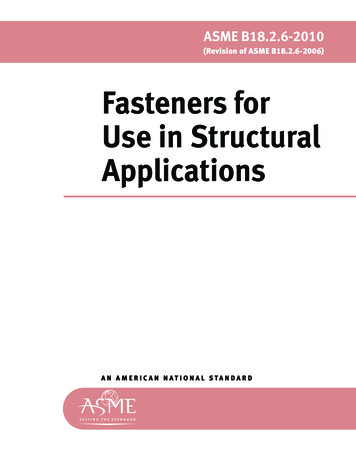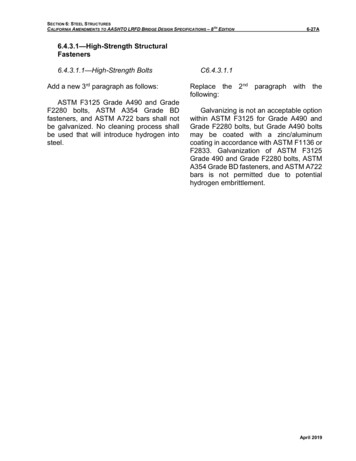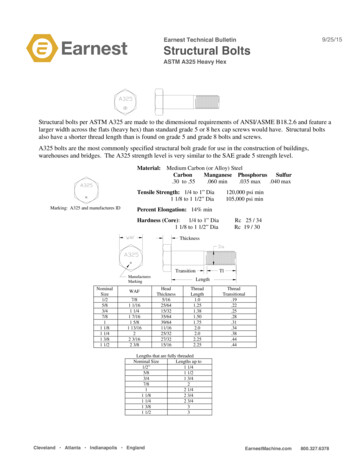
Transcription
ASME B18.2.6-2010(Revision of ASME B18.2.6-2006)Fasteners forUse in StructuralApplicationsA N A M E R I C A N N AT I O N A L STA N DA R D
INTENTIONALLY LEFT BLANK
ASME B18.2.6-2010(Revision of ASME B18.2.6-2006)Fasteners forUse in StructuralApplicationsA N A M E R I C A N N AT I O N A L S TA N D A R DThree Park Avenue New York, NY 10016 USA
Date of Issuance: August 20, 2010This Standard will be revised when the Society approves the issuance of a new edition. There willbe no addenda issued to this edition.ASME issues written replies to inquiries concerning interpretations of technical aspects of thisStandard. Periodically certain actions of the ASME B18 Committee may be published as Cases.Cases and interpretations are published on the ASME Web site under the Committee Pages athttp://cstools.asme.org as they are issued.ASME is the registered trademark of The American Society of Mechanical Engineers.This code or standard was developed under procedures accredited as meeting the criteria for American NationalStandards. The Standards Committee that approved the code or standard was balanced to assure that individuals fromcompetent and concerned interests have had an opportunity to participate. The proposed code or standard was madeavailable for public review and comment that provides an opportunity for additional public input from industry, academia,regulatory agencies, and the public-at-large.ASME does not “approve,” “rate,” or “endorse” any item, construction, proprietary device, or activity.ASME does not take any position with respect to the validity of any patent rights asserted in connection with anyitems mentioned in this document, and does not undertake to insure anyone utilizing a standard against liability forinfringement of any applicable letters patent, nor assumes any such liability. Users of a code or standard are expresslyadvised that determination of the validity of any such patent rights, and the risk of infringement of such rights, isentirely their own responsibility.Participation by federal agency representative(s) or person(s) affiliated with industry is not to be interpreted asgovernment or industry endorsement of this code or standard.ASME accepts responsibility for only those interpretations of this document issued in accordance with the establishedASME procedures and policies, which precludes the issuance of interpretations by individuals.No part of this document may be reproduced in any form,in an electronic retrieval system or otherwise,without the prior written permission of the publisher.The American Society of Mechanical EngineersThree Park Avenue, New York, NY 10016-5990Copyright 2010 byTHE AMERICAN SOCIETY OF MECHANICAL ENGINEERSAll rights reservedPrinted in U.S.A.
CONTENTSForeword . . . . . . . . . . . . . . . . . . . . . . . . . . . . . . . . . . . . . . . . . . . . . . . . . . . . . . . . . . . . . . . . . . . . . . . . . . . . . .Committee Roster . . . . . . . . . . . . . . . . . . . . . . . . . . . . . . . . . . . . . . . . . . . . . . . . . . . . . . . . . . . . . . . . . . . . .Correspondence With the B18 Committee . . . . . . . . . . . . . . . . . . . . . . . . . . . . . . . . . . . . . . . . . . . . . .ivvivii1Introductory Notes . . . . . . . . . . . . . . . . . . . . . . . . . . . . . . . . . . . . . . . . . . . . . . . . . . . . . . . . . . . . . . . . . .12Heavy Hex Structural Bolts: ASTM A 325 and ASTM A 490. . . . . . . . . . . . . . . . . . . . . . . . . . . . .23Heavy Hex Nuts: ASTM A 563 and ASTM A 194 . . . . . . . . . . . . . . . . . . . . . . . . . . . . . . . . . . . . . . .54Hardened Steel Washers. . . . . . . . . . . . . . . . . . . . . . . . . . . . . . . . . . . . . . . . . . . . . . . . . . . . . . . . . . . . .75Compressible Washer-Type Direct Tension Indicators . . . . . . . . . . . . . . . . . . . . . . . . . . . . . . . . . .106Twist-Off-Type Tension Control Structural Bolts: Heavy Hex and Round:ASTM F 1852 and ASTM F 2280 . . . . . . . . . . . . . . . . . . . . . . . . . . . . . . . . . . . . . . . . . . . . . . . . . . .10Figure1 Groove Diameter . . . . . . . . . . . . . . . . . . . . . . . . . . . . . . . . . . . . . . . . . . . . . . . . . . . . . . . . . . . . . . . . . .13Tables1 Dimensions of Heavy Hex Structural Bolts . . . . . . . . . . . . . . . . . . . . . . . . . . . . . . . . . . . . . . . . .2 Maximum Grip Gaging Lengths and Minimum Body Lengths for Heavy HexStructural Bolts . . . . . . . . . . . . . . . . . . . . . . . . . . . . . . . . . . . . . . . . . . . . . . . . . . . . . . . . . . . . . . . . . .3 Dimensions of Heavy Hex Nuts for Use With Structural Bolts . . . . . . . . . . . . . . . . . . . . . . .4 Dimensions for Hardened Steel Circular and Circular Clipped Washers . . . . . . . . . . . . .5 Dimensions of Hardened Beveled Washers With Slope or Taper in Thickness 1:6 . . . . .6 Dimensions for Compressible Washer-Type Direct Tension Indicators . . . . . . . . . . . . . . . .7 Dimensions of Twist-Off-Type Tension Control Structural Bolts: Heavy Hex Headand Round Head Configurations . . . . . . . . . . . . . . . . . . . . . . . . . . . . . . . . . . . . . . . . . . . . . . . .iii-- ,, , , , ,,, ,, ,,, ,,, - - ,, ,, , ,, ---246891112
FOREWORDThe B18 Standards Committee for the standardization of bolts, screws, nuts, rivets, and similarfasteners was organized in March 1922 as the B18 Sectional Committee under the aegis of theAmerican Engineering Standards Committee (later the American Standards Association, thenthe United States of America Standards Institute and, as of October 6, 1969, the American NationalStandards Institute, Inc.), with the Society of Automotive Engineers and the American Societyof Mechanical Engineers as joint sponsors. B18 Subcommittee 2 was subsequently establishedand charged with the responsibility for technical content of standards covering wrench headbolts and nuts.Subcommittee 2, after appraisal of the requirements of industry, developed a proposed standardseries of bolt head and nut dimensions. This proposal was finally approved and designated aTentative American Standard in February 1927.A first revision of the document was designated as an American Standard in March 1933, andwas followed by a second revision, which was granted approval as an American Standard inJanuary 1941.Following reorganization of the B18 Committee in 1947, Subcommittee 2 was asked to expandthe Standard on head proportions into a complete product standard. A proposal covering squareand hexagon head bolts and nuts, hexagon head cap screws, and automotive hexagon head boltswas prepared and submitted to the B18 Committee in April 1950. While this draft was underconsideration, the B18 Committee received a proposal from the British Standards Institutionfor unification of dimensions on products incorporating unified screw threads. The Committeewelcomed the opportunity of discussing the proposals and an American-British-CanadianConference was held in New York, June 1 and 2, 1950.It was agreed in the Conference that the essentials of unification could be accomplished byselection of mutually satisfactory across-the-flats dimensions, since this would permit the use ofthe same wrenches and because other features would rarely affect interchangeability. After dueconsideration, suitable existing across-the-flats dimensions were selected for the hexagonproducts.In its meeting on October 13, 1950, Subcommittee 2 agreed to incorporate in the proposedstandard the conference recommendations on 1 4 in. hexagon head bolts, 5 8 in. hexagon head capscrews and automotive hexagon head bolts, 5 16 in. and 3 8 in. regular hexagon and square nuts,and 7 16 in. light and regular hexagon and square nuts. At a subsequent meeting of Subcommittee 2,further changes were adopted in order to combine the light and regular series of nuts and tocombine the automotive hexagon head bolt, hexagon head cap screw, and regular hexagon headclose tolerance bolt.In view of the progress made in the United States and the urgency of standardization formutual defense, the British Standards Institution sponsored a second Conference in London inApril 1951 to complete the unification of certain hexagon bolts and nuts.At a meeting on June 8, 1951, Subcommittee 2 reaffirmed its acceptance of the unified dimensions,which corresponded with those in the March 1951 draft, but attempted to select better nomenclature for the unified products. A final draft incorporating the nomenclature Finished HexagonBolts and Nuts and containing numerous editorial changes was submitted for letter ballot inSeptember 1951. Following approval by the B18 Committee and the sponsors, the proposal waspresented to the American Standards Association for approval and designation as an AmericanStandard. This was granted on March 24, 1952.Recognizing the Standard was in need of additional refinements, Subcommittee 2 began immediately to revise it: removing inconsistencies with respect to fillets, improving the length toleranceson heavy hexagon bolts, and incorporating numerous other corrections and clarifications. Themost noteworthy editorial change was a decision to combine the coverage for hexagon cap screwsand square head set screws from the B18.2 Standard with the coverage for slotted head capscrews and slotted headless set screws from the B18.6 Standard and publish them in a separate-- ,, , , , ,,, ,, ,,, ,,, - - ,, ,, , ,, ---iv
document. The requirements for the unified hexagon cap screws and finished hexagon bolts beingidentical in the overlapping sizes, this data would now be available in two publications. Followingapprovals by the B18 Committee and sponsor organizations, the proposal was submitted to theAmerican Standards Association and declared an American Standard on February 2, 1955.A revision of this document comprised of numerous editorial corrections and inclusions of anappendix for grade markings was duly approved and designated an American Standard onApril 18, 1960.At a meeting in February 1960, Subcommittee 2 approved a recommendation to reduce the headheights for heavy, heavy semifinished, and heavy finished hexagon bolts which was subsequentlyapproved by letter ballot of the B18 Committee on August 16, 1960. A proposed standard forheavy hexagon structural bolts submitted and accepted by Subcommittee 2 at its October 17, 1960meeting was approved by letter ballot of the B18 Committee on May 9, 1961. To meet the urgentneeds of the steel construction industry, it was considered necessary to publish the Standard forthe structural bolts immediately. Consequently, Appendix IV to ASA B18.2-1960 containing coverage for the revised heavy hexagon bolts and the new heavy hexagon structural bolts was releasedin 1962.In October of 1961, Subcommittee 2 appointed a subgroup to review all product standards forsquare and hexagon bolts, screws, and nuts, and to recommend simplifications which would becompatible with technical, production, and distribution advances that had occurred over theprior several years. The subgroup presented its recommendations at a meeting of Subcommittee 2in October 1962. It was agreed that the internally and externally threaded products should bepublished in separate documents as suggested, and draft proposals for each were completed.The proposed revision for square and hex bolts and screws incorporated the following subgrouprecommendations: consolidation of hexagon head cap screws and finished hexagon bolts into asingle product, consolidation of heavy semifinished hexagon bolts and heavy finished hexagonbolts into a single product, elimination of regular semifinished hexagon bolts, new length tolerancing values for all bolts and screws, documentation of a positive identification procedure fordetermining whether an externally threaded product should properly be designated a bolt or ascrew, and an abbreviated and purified set of product nomenclature reflecting application of theidentification procedure. Letter ballot of this proposal to the B18 Committee in March 1964resulted in several comments, which were resolved to the satisfaction of the Committee inJune 1964. Following acceptance by the sponsor organizations, the revision was submitted tothe American Standards Association and was designated American Standard ASA B18.2.1 onSeptember 8, 1965.Subcommittee 2 in 1992 recognized the value of having all structural products in a singlestandard. In a revision initiated for the B18.2.1 Standard in that year, it was proposed to removethe heavy hex structural bolt from the B18.2.1 Standard, the heavy hex nut from the B18.2.2Standard and combine these with the dimensions of hardened steel washers from ASTM F 436and the compressible-washer-type direct tension indicator dimensions of ASTM F 959. This newStandard would then provide all standardized dimensions for the fasteners intended for use instructural applications. The first draft of this Standard was submitted to Subcommittee 2 atits May 1993 meeting. It was subsequently approved as an American National Standard onDecember 4, 1996.In December of 2008 the B18.2 Subcommittee agreed to begin the updating of ASME B18.2.6.The document’s format was revised to meet the new guidelines for B18 Standards. The insidediameters of the hardened washer were revised to match the revised size indicated in ASTM F 436.An alternative design for the 5 8 in. size compressible-washer-type direct tension indicator wasintroduced to simplify production tooling for some washer manufacturers. References to platingsand coatings in the various product sections were removed and the users of this Standard aredirected to the appropriate ASTM material standard to determine finish requirements in additionto other physical and mechanical properties. The quality assurance section was simplified byremoving the reference to ASME B18.18.1 and the list of designated inspection characteristics.Instead, users are directed to ASME B18.18.2 for the quality assurance requ
ASME B18.2.6-2010 (Revision of ASME B18.2.6-2006) Fasteners for Use in Structural Applications. INTENTIONALLY LEFT BLANK. ASME B18.2.6-2010 (Revision of ASME B18.2.6-2006) Fasteners for Use in Structural Applications AN AMERICAN NATIONAL STANDARD Three Park Avenue New York, NY 10016 USA. Date of Issuance: August 20, 2010 This Standard will be revised when the Society










